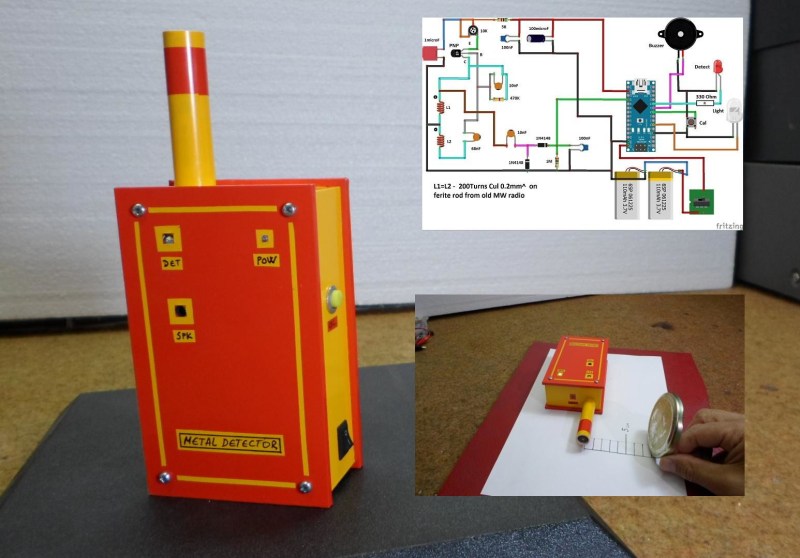Full-size metal detectors are great for narrowing down a region to start digging through. But what if you had a smaller metal detector that could pinpoint the location? Then you could spend far less time digging and way more time sweeping for metal.
Metal detectors work because of the way metal behaves around electromagnetic fields. [mircemk] reused the ferrite core from an old MW radio to build the antenna coils. When metal objects are close enough, the induced electromagnetism changes the frequency, and the Arduino blinks an LED and beeps a buzzer in time with the new frequency.
[mircemk]’s handheld metal detector is quite sensitive, especially to smaller objects. As you can see in the demo video after the break, it can sense coins from about 4cm away, larger objects like lids from about 7 cm, and tiny things like needles from a few millimeters away. There’s also an LED for treasure hunting in low light.
Don’t want to pinpoint a bunch of useless junk? Build in some phase detection to help you discriminate.















I need something like this. I have an old house (~300 years) and always find stuff with a cheapo metal detector I bought years ago. Time for an upgrade.
It’s what people call a ‘pin-pointer’. Which is handy, after you dig the hole, or shallow/surface metals. Harbor Freight had one that could be had for under $20, but really needed a couple of simple and cheap refinements. The hobby level pin pointers are around $150, a little spendy, since you won’t need it, every target you recover, and can do fine without one, anyway. Preference and convenience… Your main detector has filters, discrimination, and a few other things, so you can focus on ‘treasure’. Pin pointers don’t, and will beep for anything. 2-3 inches of dirt, isn’t tough to poke around through. You can learn to pin point pretty accurately, before you ever lay down your main detector, to begin recovering you treasure.
Not true. Minelab makes a pin pointer that discriminates iron. You need to do better more accurate research.
Research? I’d rather be out searching… I prefer to go light, and cheap, it’s just a hobby, not a career. From practical experience, a pin pointer is a useful tool, sometimes. Lot of times, not even needed. Guess if you are in a race to make your mortgage payment, a few seconds makes a huge difference.
A pin pointer makes finding a target a hell of a lot easier. Sure, your detector probably has a pinpoint mode if you’re in the hobby, but if you’re finding much more than change just below the surface a pin pointer will be your best friend. I go out light, but never without my pointer. Digging a quarter at an inch with a cheap detector is easier than digging a target a foot down with a more advanced detector.
I never quite understood why people used diode detectors when one could use the diode in the BE junction of a bipolar transistor and get some gain. Many years ago, before transistors were invented, or were very expensive, this practice may have been relevant, but not anymore.
An opamp would do well here. If you must use diodes then you would get far more sensitivity from germanium diodes instead of 1n4148 SS silicone diodes.
Peak Inverse voltage of a 1N4148 is “like one hundred” volts and base emitter junctions are “like five volts” so even just stray induced voltage could mess up a transistor-diode pretty bad. Also reverse biased transistors are legendary noise sources so people assume as low signal detectors they’re gonna have very bad noise performance which technically is not true until they’re run in zener mode which is a long story.
I understand your point, but … Dude. Read the first paragraph. https://www.minelab.com/knowledge-base/getting-started/how-metal-detectors-work. You will understand where he is coming from better.
Only “needle” I need to find is a leaky water pipe.
Great!… If you’re looking for large items less than 7cm under the surface